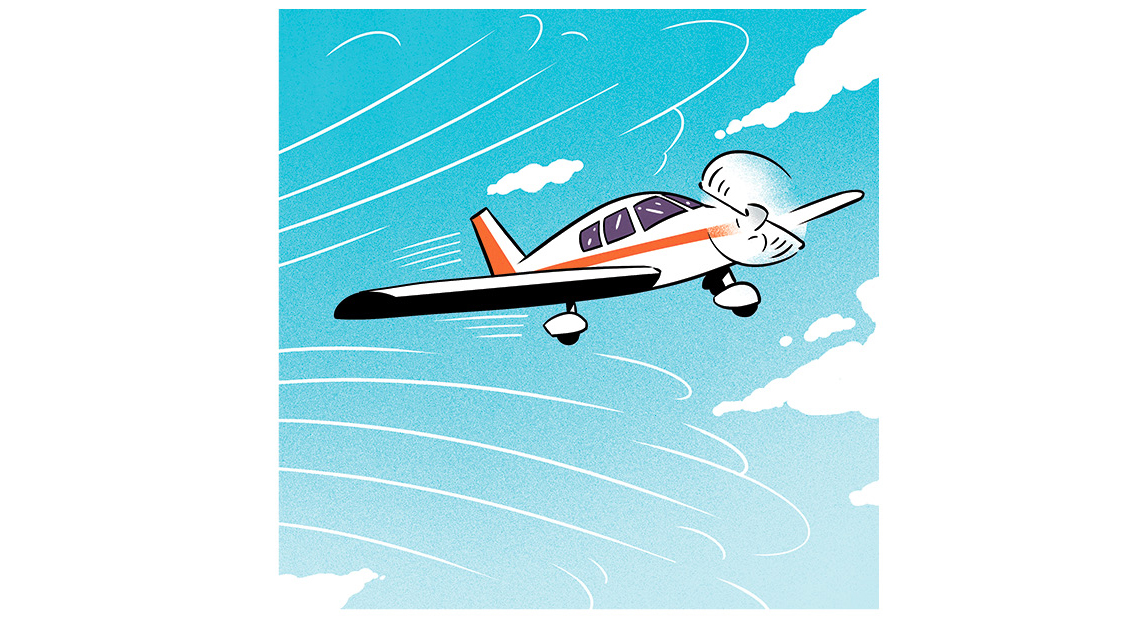
Checkride-ready
See how you measure up to FAA standards with questions from the AOPA Pilot Information Center.
1. Which statement best defines hypoxia?
A. A state of oxygen deficiency in the body.
B. A condition of gas bubble formation around the joints or muscles.
C. An abnormal increase in the volume of air breathed.
2. Which type of weather briefing should a pilot request, when departing within the hour, if no preliminary weather information has been received?
A. Outlook briefing.
B. Standard briefing.
C. Abbreviated briefing.
3. What document(s) must be in your personal possession or readily accessible in the aircraft while operating as pilot in command of an aircraft?
A. An appropriate pilot certificate and an appropriate current medical certificate if required.
B. A pilot certificate with an endorsement showing accomplishment of an annual flight review and a pilot logbook showing recency of experience.
C. Certificates showing accomplishment of a checkout in the aircraft and a current flight review.
4. Which is normally prohibited when operating a Restricted category civil aircraft?
A. Flight under instrument flight rules.
B. Flight within Class D airspace.
C. Flight over a densely populated area.
5. Which of these represents the shortest distance?
A. One nautical mile.
B. One statute mile.
C. One kilometer.
D. One country mile.
 Ace
Ace
Can you correctly answer these questions from retired TWA captain and 28,000-hour pilot Barry Schiff?
6. True or false? A pilot has not flown for more than 90 days. He then makes three solo takeoffs and landings at night. He may now carry passengers during the day.
7. To maximize gliding distance while gliding with a tailwind, a pilot should use
A. the glide speed published in the pilot’s operating handbook.
B. an airspeed that is greater than the published glide speed.
C. an airspeed that is less than the published glide speed.
8. Which of the following does not belong?
A. acceleration error
B. dip error
C. heeling error
D. northerly turning error
9. The battery of an emergency locator transmitter (ELT) must be replaced after it has been used for more than _____ minutes or after it has been installed for more than _____ percent of its useful life.
10. True or false? An airplane with a 36-foot wingspan is in a 45-degree-banked turn at a true airspeed of 120 knots while at a constant altitude near sea level. A pitot tube on each wing tip serves its own airspeed indicator in the cockpit. It would be difficult for a pilot to see any difference in the indicated airspeed between one gauge and the other.
Final exam answers
1. The correct answer is A. Hypoxia refers to a lack of oxygen in the body, by either reduced oxygen or not enough oxygen. (Pilot’s Handbook of Aeronautical Knowledge, Chapter 17)
2. The correct answer is B. The pilot has no knowledge of the route weather, and is leaving soon, so the proper briefing to obtain is a full route standard weather briefing. (1800wxbrief.com)
3. The correct answer is A. A pilot certificate must always be on board for any flight, as must a medical certificate, if the pilot is operating under the provisions of either a first, second, or third class medical. (Federal Aviation Regulation 61.3)
4. The correct answer is C. According to FAR 91.313, flights over densely populated areas or in congested airways are prohibited.
5. The correct answer is C. To the nearest whole number, one nautical mile is 6,076 feet, one statute mile is 5,280 feet, and one kilometer is 3,281 feet. One country mile can take hours to get there—likely the longest of the four!
6. True. The regulations only require the pilot to have made three takeoffs and landings within the previous 90 days to legally carry passengers during the day. Daytime conditions are not specified, although currency must be obtained at night to carry passengers at night.
7. The correct answer is C. Reducing airspeed reduces sink rate, which causes the airplane to remain in the air longer. This increases the time during which the pilot can take advantage of the tailwind to extend his glide range. The amount of airspeed reduction depends on wind speed.
8. The correct answer is B. Magnetic dip is not an error. The other choices are errors caused by dip, the vertical component of the Earth’s magnetic field at any given location.
9. 60 minutes, 50 percent.
10. True. The true airspeed of the outer wing tip in this case is only one knot greater than that of the inner wing tip.

